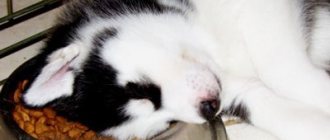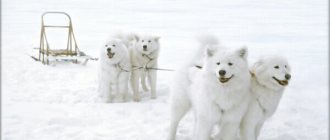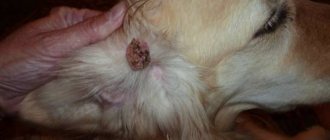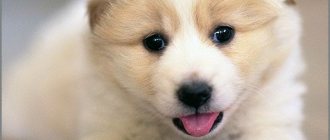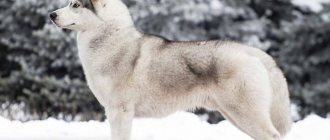Relationship between a dog's age and human years
Are you wondering how old your four-legged friend will be, in human age? To get the equivalent human age of a pet, you just need to multiply it by 7 or 6. This is approximately the case. Compare: dogs reach adulthood already at the age of two, when people need 18 years to do this. At 18 months, the dog will feel as fresh and cheerful as a person at 20.
On average, a dog lives up to 12 years. The figure depends on the breed, quality of life, genetics and other factors. Converted to human years, this would be approximately 64-77 years. When a dog turns 16, he feels like a full-fledged 90-year-old inhabitant of our planet.
There is another version. To obtain a dog's age similar to a human's, the multipliers must be gradually changed. For example, when a puppy is 2 months old, we multiply its age by 7, we get 14 human years. But upon reaching the age of six months, the puppy jumps sharply in development and its age is already equal to 5-6 human years, since the multiplication coefficient immediately changes to 10. 1 year is equal to 15 human years.
It is impossible to compare human and dog (or cat) ages with 100% objectivity, so we are content with those calculations that are quite realistic to make.
Determining the age of the puppy
Finding out how many months a puppy is is not as difficult as an adult dog.
- A newborn puppy can be identified just by looking at the four-legged animal. His eyes are closed and there are no teeth at all. The puppy does not walk yet, he sleeps most of the time. The baby just squeaks quietly to attract her mother's attention. Using touch, he finds his mother's nipples and feeds only on breast milk. It will remain this way until about 2-3 weeks of life.
- After the first weeks, the puppy’s eyes gradually open, but he still cannot see fully. Gradually he distinguishes sounds and smells.
- From the first month of life, the baby begins to walk and explore the world around him. The exact age from a month to a year can be determined by the condition of his teeth. Up to 2 months, your pet’s baby teeth are just forming. Starting from the second month of life, baby teeth are replaced by molars. By the age of 1 year, the dog's molars should be fully formed. Between 6 and 12 months, puppies begin puberty, and girls go into heat.
- From 1 to 2 years old, a dog is considered a teenager. Dogs of large and medium breeds stop growing at this age. Large breed puppies continue to develop until they are 2 years old. Starting from the age of two, the pet is considered an adult.
How to understand how old an adult dog is
We tried to figure out how to determine the age of a puppy. What about an adult dog? There are also some subtleties here that will allow you to find out approximately how many years a dog lives in the world:
Teeth
– the easiest way to determine a dog’s age is by its teeth. In short, the better the condition of the teeth (white enamel, full teeth, missing teeth, etc.), the younger the dog. If you look at the teeth more closely, you can come to the following conclusions:
- Dogs 1-2 years old have teeth that are not ground down, without tartar and caries, and are white;
By the age of 2.5-3 years, the lower incisors of dogs begin to wear off slightly; by the age of 4, this also happens with the upper incisors, but the color of the enamel is still white;
The 5-year-old dog has rounded canines. The teeth themselves are no longer so white, there may be a yellow coating, small carious holes;
At 6 years of age, teeth are noticeably yellow and thin. The canines are short, sometimes almost level with the incisors;
- most often, when a dog has gray hairs on his nose, he is already more than 6-7 years old. However, graying occurs occasionally in younger animals;
Wool
– dogs after 7-8 years of age have dull and unkempt fur. Young animals have no problems with their fur coat (if the animal is healthy);
Leather
– in animals older than 8-10 years, the skin loses its elasticity, it can easily be pulled back quite strongly (the skin on the abdomen looks especially saggy in bitches who have given birth repeatedly);
Eyes
– doggies up to 6-8 years old have bright, full of life eyes. Older dogs lose their sparkle in their eyes and look tired. Very old animals are unlikely to be interested in sparrows chirping nearby or children's laughter;
Movements.
If a young dog is active most of the time, then the older animal (in dogs of small breeds old age begins after 10-12 years, and in large breeds at 6-8 years) quickly gets tired and chooses calm walking instead of running. Older dogs usually spend the lion's share of their time lying in a quiet and calm corner. The animal's reactions are slow. Dogs over 8 years old almost always have at least minor problems with their joints, which may result in lameness and unsteady gait;
Weight
– Older dogs have a slower metabolism, which is why they are often overweight. Of course, obesity can also occur in young animals, but pets aged 7 years and older are still prone to it;
- in animals older than 7-10 years, the following ailments are often found: heart failure, diseases of the motor system (osteoarthritis, arthrosis, joint dysplasia, etc.), kidney ailments (pyelonephritis, nephrosis, renal failure, etc.), hearing impairment , visual impairment (cataracts, glaucoma, etc.), gynecological problems in bitches (pyometra, oncology, etc.).
Teeth
It is easy to determine the age of a dog by looking at its teeth. Veterinarians and dog handlers most accurately determine the age of an animal precisely by the condition of its teeth. Below is a complete table of the relationship between the number of teeth a dog has and its age.
| Age | Dental condition |
| From birth to 2-3 weeks | No teeth |
| 3-4 weeks | Milk hooks and fangs are just beginning to emerge |
| 4-5 weeks | Deciduous incisors appear |
| 5-7 weeks | The remaining teeth are emerging |
| 2 months | All baby teeth are there |
| 2-4 months | First, hooks and fangs are replaced with molars. |
| 3-5 months | Middle incisors change to molars |
| 4-6 months | Deciduous rear incisors are replaced by molars |
| Six months | Baby fangs are the last to fall out |
| 1 year | White teeth with tubercles |
| 2 years | On the lower toes, the tubercles are gradually worn away, but the teeth do not lose their beautiful appearance |
| 4 years | The upper tubercles wear away, the teeth lose their brightness |
| 5 years | Yellow plaque on teeth, possible formation of tartar |
| 6 years | Teeth are yellow, wear out, change shape |
| 8-10 years | The fangs are dull, the teeth are very worn. The enamel is clearly yellow |
| Over 10 years old | Teeth loosen and fall out, bite is disrupted |
How to determine the age of a dog: various methods of determination
There are many unscrupulous owners. Some people do not carefully monitor animals - dogs run away, others throw an animal that does not suit them into the street. When a dog is selected and found, the question arises of how to determine the dog’s age. This is necessary for examination by a veterinarian, vaccination, to create an announcement about the foundling, in order to know how to care for it, what to feed and how long to walk.
To determine the age, the pet is examined. As a person grows and ages, special signs appear, similar to what happens in animals. A puppy cannot be confused with an old animal. Veterinarians know how to find out a dog’s age more accurately by external signs. And among dogs there are long-lived people. The oldest dog died at 29 years old, but this is a rare exception. Most dogs live 10-16 years.
The second common question among pet owners related to age is whether it is possible to compare it with a human one. Knowledge is not very important, but interesting. The age of a dog by human standards can be approximately calculated using coefficients or viewed more accurately in special charts.
Comparison of human and canine ages
Knowing the average life expectancy of a person and a dog, it is easy to determine the conversion factor as 7 human years for 1 dog year. A rough estimate is given. In fact, the human age of a dog cannot be calculated using this scheme.
The puppy develops quickly. In the first year of life, he manages to catch up with the development of a 16-year-old teenager. For this reason, puppies receive increased attention.
It is recommended to devote a lot of time to education and proper feeding, or time will be lost. The exact age of a puppy is easy to determine by observing its developmental stages.
At 2 years old, the dog will be 24 in human years. Then maturation slows down.
Medium and small pets age more slowly than large and giant pets. Medium-sized dogs are considered to have longevity; traumatic injuries to dogs are less likely. Small pets go through 5 human years per year, large ones – 6, and largest ones – 7 years.
14 years of a large dog - 108 human years. The relationship between the age of the dog and the person helps determine the rules of care. From the age of 8, dogs are considered to be old; indeed, at the age of 55-66 people retire, their workload decreases, and their diet changes. The coefficient shows that small breeds are able to live longer.
How to determine age by teeth
An accurate method for determining age is to examine the dog's teeth. Like humans, animals' teeth change once in a lifetime. Based on the condition, you can roughly calculate the number of years.
An accurate assessment is possible if the dog has the correct bite, the animal was kept in good conditions, without serious illnesses.
The age of a dog by teeth helps to determine the number of full years for pets without accompanying documents.
For puppyhood, the following laws apply:
- The newborn has no teeth. Milk hooks and fangs will begin to cut on the 20-25th day. The incisors appear at 30-35 days, and the primary molars appear a little later. At 1-2 months the puppy has a full set of teeth, if there are no deviations. Usually puppies are kept with their mothers until 2-3 months.
- The second stage of determining age is the change of teeth. The toes, or front incisors, are the first to change at 2-4 months, depending on the breed. 3-5 months is the time for the change of straight teeth - middle incisors, up to 4-6 months the edges change and at about the 6th month new canines grow.
- Final stage. As dogs grow, their teeth change. The molars and false molars change, and the remaining teeth grow. At one year the dog has a full set of teeth, the animal is large and muscular. Only the fur is short. The one-year-old pet has snow-white teeth with characteristic tubercles.
In large dogs, the change from dairy to primary is faster. Diseases and ear cropping can slow down the course. The described slows down the development of the puppy as a whole.
In the future, to determine the age of the quadruped, they look at the abrasion of the tubercles. Young incisors and molars exhibit specific trefoil-shaped protuberances that disappear as they grow older. To clarify the number of years, look at the form:
- 2 years – the tubercles on the hooks on the lower jaw are erased;
- 4 years – the tubercles on the upper hooks are erased, the color of the enamel becomes dull;
- 5 years - the tubercles are erased from the incisors, yellowing of the enamel is noticeable. The fangs become a little dull;
- 6 years – worn incisors take on a concave shape, it is difficult to determine the correct bite:
- 8-10 years - the crowns have time to wear out, the fangs are short and blunt, the teeth are yellow;
- older age – teeth become loose and fall out, tartar is visible, caries is possible.
Many factors influence tooth wear. The correspondence between the age of a dog and a person can be clearly seen from the teeth. The older the pet, the more likely dental disease is. Older pets often have their teeth specially cemented and strengthened so that they do not wear out. They carry out procedures to treat caries, remove plaque and tartar.
Teeth wear out faster than expected in dogs with malocclusion. The scissor type speeds up the process 2 times. Underbite helps maintain hooks on the lower jaw. Carrying hard objects, stones or iron accelerates tooth wear.
Dogs in kennels often chew on iron bars, which accelerates tooth wear. It is not advisable to give hard bones to dogs often.
And soft food leaves its mark - teeth become fragile, loose and susceptible to caries and the formation of tartar.
Other ways to estimate a dog's age
Physical examination is used to determine age. If the teeth do not give a complete picture or there is a high probability of making a mistake, look at:
- Muscle tone. The young age of a person and a dog will show a healthy body: well-developed muscles, activity. A young dog will start running more than sleeping. Older dogs will prefer to sleep longer and walk less. Older people develop muscle atrophy or obesity.
- Wool cover. Pure silky and soft fur is characteristic of a young animal. The older the dog, the coarser the coat and the faster it gets dirty. If the color is dark, the older dog will have gray hair visible on its muzzle near the lips. This is a subjective assessment of the dog’s age; the condition is greatly influenced by housing and nutritional conditions. Some breeds are completely devoid of fur.
- Eyes. Clarity and sparkle in the eyes are inherent in any dog in puppyhood and in adulthood. An old dog's eyes are cloudy, dull and opaque. Eye diseases usually appear in older dogs.
By external signs
Umbilical cord. The presence of an umbilical cord indicates that the puppy was recently born. If the umbilical cord is still fresh, the puppy is no more than a day old. On the 2nd day it dries up, and on the 3rd it is already separated from the dog’s belly.
Eyes. The puppy remains blind until 10-20 days of its life. The eyes should open before the first month. The cloudy and gray-blue color of the iris is characteristic of tsutsiki for up to a month. Clear eyes are characteristic of dogs one month and older. It is worth paying attention to the dog's gaze.
Ears. In the first days of life, the puppy does not hear anything. The baby will begin to recognize the first sounds only after the second week of life, and to fully hear by the month. As the puppy grows, its ears grow.
Weight. Obviously, a small puppy will weigh differently than an adult dog. There are tables of approximate weights for small and large breeds at all ages.
For dwarf breeds:
| Type | Newborn | 4 weeks | Six months | One and half year |
| Dwarf | 70-80 grams | 200-230 grams | 715-920 grams | 1-1.2 kg |
| Small | 90-100 grams | 270-320 grams | 1-1.2 kg | 1.4-1.9 kg |
| Average | 120-130 grams | 455-485 grams | 1.6-1.8 kg | 2.1-2.3 kg |
| Big | 145-170 grams | 540-650 grams | 1.9-2.2 kg | 2.4-3 kg |
For large and medium breeds, other parameters are presented. Knowing how much a dog of a particular breed should weigh at maturity, you can find out whether it has reached canine adulthood.
You need to be especially careful with giant breeds, as their dimensions develop very, very rapidly. One-month-old Labrador puppies weigh from 3.4 to 3.6 kg and grow to 30-40 within two years. The weight of an 11-month-old Rottweiler can already reach 50 kg.
Dog's teeth instead of a passport
Adult dog
The one-year-old dog shines with a snow-white smile without plaque or tartar, the crowns retain their original shape, and the cusps and areas of the chewing surface are well defined. The older the pet, the more noticeable the process of tooth wear is. In this case, dog handlers make an age diagnosis in increments of one year for adult dogs and two for older dogs.
- 2 years: noticeable erasing of the trefoil of the middle incisors occurs, the corollas become less prominent or become even smaller. Teeth lose their original shine and become dull.
- 3 years: the blades of the middle incisors completely disappear, abrasion of the toes begins. The first gum diseases are also characteristic of this age: yellow plaque and tartar appear.
- 4 years: the chewing surface of the toes and middle incisors is completely smooth, without trefoils, the turn of the edges has arrived.
- 5 years: with the complete absence of trefoil on all incisors, the apex of the canine is slightly smoothed.
- 6-7 years: the older the pet gets, the more noticeable the wear of the teeth is. How do you know how old a dog is if its fangs are blunt and yellow in color? This means that in front of you is an adult animal about 6 years old. If the hooks on the lower jaw have acquired an oval shape (the shape of a chicken egg), then we can safely add another year of life.
Canine maturity
The ovoid shape of the incisors is typical for dogs aged 7 years and older. So, by the age of 8-9 years it is acquired by the middle incisors, and by the age of 10 - by the upper toes. It is worth paying attention to the smoothness of the masticatory cusps of the molars and premolars, and how worn the fangs are. From the age of 11-12 years, a dog can begin to lose teeth almost in the same order in which they grew. If there are not only no hooks in the mouth, and their absence is not associated with injuries, then we are talking about an old man who has become wise in life.
How to find out how old a dog is: appearance tells about age
Despite the specificity of the dental method, if you rely only on it, errors are possible. The fact is that the appearance of an adult’s teeth, in addition to age, is influenced by living conditions. Poor nutrition, malocclusion, and other reasons why a dog is forced to survive rather than live – wear out teeth much faster. Therefore, it would be correct to assess the condition of the tailed pet using several other indicators.
Wool, or what type of coat the dog has
Young animals have softer coats and are less susceptible to dirt. With age, the fur coat becomes dull and becomes oily. The first gray hair appears by the age of 6-7 years, starting on the chin, around the lips. Gradually it descends to the chest, touching the front paws. The older the dog, the more uneven the coat grows. If old people are poorly cared for, the likelihood of “shreds in different directions” is quite high.
Eyes to eyes
Does the miracle have devils dancing in its eyes and showing their tongues, an interested and clear look? This means we are talking about a puppy or a young dog. The cornea of a healthy animal is bright, without any discharge. Whereas with each passing year, the gaze becomes cloudy, becomes dull, and tears appear.
Muscle condition
In older dogs, muscle tone is lower, mild atrophy is possible, and bones protrude more. This is due to a decrease in overall activity. Young pets are always ready for hide and seek, catch up and any other games. But an adult dog will never miss an opportunity to rest once again.
When looking for information on how to find out how old a dog is , you need to take into account the fact that representatives of large breeds age faster. While the little ones retain their youth a little longer.
Adult age
It is considered more difficult to accurately determine the number of years a dog is after three. The fact is that a dog’s age is determined mainly by its teeth. After the formation of all molars, the animal does not undergo any changes for a long time.
The dog develops fully during the second year of life. A dog that has reached not only sexual, but also behavioral maturity is considered fully mature. What distinguishes an adult dog from a puppy is a change in its behavior with others.
How to determine the physical maturity of a dog? Bitches reach puberty much earlier than males. At the age of 6-8 months, girls begin their first heat. If you notice an animal in heat, this means that she is definitely older than 8 months. It is important to monitor her all this time and prevent early pregnancy. Only a girl who has already reached 18 months of age is suitable for reproduction. Boys are also recommended to be crossed only after reaching the age of two.
A pet that has reached the age of seven can be considered elderly. Characteristic signs that the dog is old:
- The pet becomes less active, sleeps a lot, does not want to go for long walks;
- Gray hair on the face appears in a pet when it reaches 6-7 years of age. It also happens that gray hairs are found in younger individuals;
- Deterioration of hearing and vision. Partial deafness;
- Temperament changes, the animal becomes more aloof;
- Decreased appetite;
- There is no sexual desire and desire to play and meet other dogs;
- Frequent urge to urinate, problems with digestion.
The above signs are normal for an older dog. But if such oddities are noticed in the behavior of an animal that, according to other signs, has not reached the age of seven, this may indicate various kinds of diseases. Be carefull!
Determining the age of a dog - why is it necessary?
How to understand how old a dog is? This question is especially relevant for those owners who picked up a mongrel on the street or have already adopted the dog as an adult. The bottom line is that in adulthood, determining how old a pet actually is is not as easy as it seems. However, why do this at all?
There are several reasons why you need to know, at least approximately, the age category of your pet:
- Proper care and nutrition depend on this. Pets in different years need to select the appropriate diet, in addition, physical activity is adjusted.
- With regard to young dogs, it is very important to adjust the time for education and training in a timely manner.
- Conducting vaccinations. This is done according to a certain schedule.
- Determining the time for mating.
- To understand when you can spay or neuter your pet.
Dog to human age ratio
It is only possible to obtain data on how many dogs there are in human years. There are a large number of tables that calculate these indicators. A person himself can calculate them if he multiplies the dog’s age by 6 or 7. The value is approximate.
Accordingly, it can be seen that the age of full maturation in dogs occurs at 2.5-3 years. Although it is worth remembering that a lot depends on the breed of the animal. So, for example, for a Jack Russell Terrier and a Great Dane, the indicators will vary significantly (the life expectancy of the latter is only 7-8 years, terriers live up to 15-20).
Medium dogs up to 12-25 kg
Medium breeds are considered to be those that reach 10 to 25 kg in weight at the age of 1.5-2 years. To determine the age of a dog, take a look at the table below. Here are the most popular breeds and their ideal weight at maturity (+- a couple of kilograms). To understand whether your dog has passed the 1.5 year mark, weigh him and compare him with the table.
| Breed name | Weight of bitches, kg | Male weight, kg |
| French Bulldog | 11,3-12 | 13-14 |
| Cocker Spaniel | 11,8-13 | 13-15 |
| Staffordshire Bull Terrier | 21 | 24-25 |
| Collie | 19-21 | 23,9-24,4 |
| Siberian Husky | 18,5-19,5 | 24-25 |
| Shar Pei | 18-20 | 24,9-26 |
Large from 25 kg
Large breeds are those whose weight ranges from 25-40 kg. Anyone who weighs more is considered a giant. The formation of such breeds as the Rottweiler or the German Shepherd completely ends when they reach two years of age. Puppies are already born large, weighing 3-4 kg.
| Breed name | Weight of bitches, kg | Male weight, kg |
| Golden Retriever | 30 | 33,7 |
| Labrador | 30-34 | 35,5-39,5 |
| German Shepherd | 28,4-30 | 35,9-40 |
| Boxer | 28,8-31 | 33,9-38 |
| Doberman | 28-33 | 39-44 |
| Rottweiler | 39,7 | 46,8-54 |
| Saint Bernard | 61-67 | 81-88 |
Tough
The expert will first look at the condition of the animal’s teeth. By the presence or absence of certain fangs, you can find out the age of the puppy. The age of an adult dog is determined by the presence of all molars and cusps on them. Above is the most complete table showing the correspondence between the years of an animal’s life and the approximate condition of its jaws.
The disadvantage of this method is that if the dog has a malocclusion or other jaw defects, diagnosis becomes difficult.
Adult dogs
If you have adopted an adult dog into your family, you should evaluate its teeth based on the degree of wear. If the dog is a year old or a little older, its teeth are usually white, clean, and free of plaque. But by the end of the second year of life, they lose their natural brightness, and in some places hard mineral deposits begin to form - the so-called tartar.
A dog’s teeth become yellow after three years, the ones that are deeper and further away turn yellow first ; by the age of five, almost all of a dog’s teeth already have a yellowish coating.
However, the method of determining age in an adult dog is not as effective as in a puppy.
This happens because a lot depends not only on the natural processes of aging and wear of tooth enamel, but also on what lifestyle the dog led, what it ate, and what diseases it has. The teeth of a dog that has the habit of chewing anything hard that comes its way may be more worn out.
If the dog ate dry food, then his jaw looks more aesthetically pleasing and “youthful” than the jaw of a dog that is accustomed to natural food.
If you see worn-out teeth and dull fangs on a dog, then you can safely say that it is definitely more than 6-7 years old. And if some of the teeth are completely missing, and the rest are worn out, there are problems with the gums, most likely, the dog is more than 10 years old.
Helpful advice: a veterinarian can more accurately determine the age of an animal, since he is able to comprehensively assess not only the condition of the teeth, but also the condition of the gums, tongue, and mucous membranes.
Table of correspondence between a dog's age and a person's age, taking into account the quality of teeth
Dog's actual age
Small dogs, suitable for human age
Medium breeds, appropriate for people's age
Large dogs, appropriate for human age
White, indigenous, sharp, without plaque.
There is no plaque, the teeth are white.
The whiteness becomes dull and a slight mineral deposit may appear.
Yellowness appears in the area of molars and premolars.
Molars and premolars turn yellow, yellowing begins in the canine area, and stone deposits are possible.
All teeth already show signs of yellowness.
Gradual wear of the front teeth and molars begins.
The fangs gradually wear out, become dull, and there are signs of tartar deposits on the back teeth.
Often all the teeth are yellow, worn down, and signs of enamel delamination and cracks may be observed on the molars.
The first loss of teeth appears; several premolars or molars may be missing. The fangs are twisted.
The loss of teeth and the distortion of the shape of the remaining ones continues, the teeth are yellow, there is plaque. There may be signs of periodontal disease.
A noticeable process of tooth loss begins. The last ones to fall out are the fangs, and the instability of the teeth increases.
The incisors are bent, the fangs are dull and unstable.
The changes are degenerative and individual.
More than half of the teeth may be missing.
Tooth loss can account for two-thirds, but in general everything is quite individual and depends on the general health of the dog.
Individual degree of loss.
According to other signs
By behavior. Little puppies love to be near their mother. They do not leave their mother, sleep, eat and play nearby, and puppies up to two weeks old cannot do anything on their own. Since a month they have been actively studying everything and walking around. From two months and older, the puppy is already running around the house with all his might and doing mischief here and there. By six months, small breeds begin puberty; large breeds mature by up to a year. Character is formed around 4-5 months.
Barking. The puppy begins to bark at 1.5-2 months of age. His voice is not so loud, but ringing and perky.
Reaction to sound. Puppies cannot fully hear until they are a month old. If the puppy does not respond to sound stimuli, either he is not 2 weeks to a month old, or he is deaf or has problems with his ears.
Briefly about the main thing
- You can find out the age of your pet yourself, without the help of a veterinarian.
- First of all, look at the teeth, since the condition of the teeth can most accurately tell how old the dog is.
- Don't rush to judge prematurely. To complete the picture, conduct a full examination of the dog. This way you can objectively assess the situation and make the most accurate conclusion about its age.
Have we answered your question fully enough? If not, write your question in the comments below and our specialist will answer it.
Did you like the article? Share it with your friends on social media. networks. This will help them get useful information and support our project.


